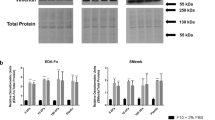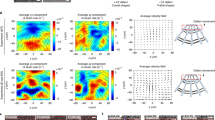Abstract
The capacity of diploid human lung fibroblasts to produce plasminogen activator was found to vary about 20–fold depending on culture conditions, particularly on the serum used to supplement the growth medium and on the substratum to which the cells are attached. Fibroblasts adapted to produce large amounts of plasminogen activator, by growing for several generation times under conditions which enhance productivity of plasminogen activator, continue to synthesize and secrete the enzyme when transferred to a serum–free medium. Enzyme synthesis is, however, regulated by a negative feedback control exerted by the extracellular enzyme. The feasibility of utilizing fibroblasts for preparation of plasminogen activator was demonstrated on a laboratory scale using batchwise and continuous processes designed to minimize the effects of the feedback control.
This is a preview of subscription content, access via your institution
Access options
Subscribe to this journal
Receive 12 print issues and online access
$209.00 per year
only $17.42 per issue
Buy this article
- Purchase on Springer Link
- Instant access to full article PDF
Prices may be subject to local taxes which are calculated during checkout
Similar content being viewed by others
References
Christman, J.K., Silverstein, S.C. and Acs, G. 1977. p. 91–149. Plasminogen activators. In A. J. Barett (ed.), Proteinases in Mammalian Cells and Tissue. Elsevier-North Holland.
Sherry, S. 1980. Mechanisms of fibrinolysis. p. 1294–1305. In W.J. Williams, E. Beutler, A. J. Erslev, and R. W. Rundles, (eds.) Hematology, McGraw-Hill, 2nd edition.
Astrup, T. 1966. Tissue activators of plasminogen. Federation Proc. 25: 42–51.
The unit of urokinase activity was adopted in 1964 by the committee of Thrombolytic Agents, National Heart Institute. This unit is based on the activity of working standard urokinase preparation which is available from WHO Laboratory International Laboratory for Biological Standards, National Institute for Medical Research, London, England.
Bernik, M.B., Wijngaards, G. and Rijken, D.C. 1981. Production by human tissues in culture of immunologically distinct multiple molecular weight forms of plasminogen activators. Ann. N.Y. Acad. of Sci. 370: 592–608.
Lesuk, A., Terminiello, L. and Traver, J.H. 1965. Crystalline human urokinase: some properties. Science 147: 880–882.
White, W.F., Barlow, G.H. and Mozen, M.M. 1966. The isolation and characterization of plasminogen activators (urokinase) from human urine. Biochemistry 5: 2160–2169.
Pye, E.K., Maciag, T. and Iyengar, R. 1977. p. 63–79. Production of enzymes and proteins in tissue culture. In Z. Bohak and N. Sharon (eds.), Biotechnological Applications of Proteins and Enzymes, Academic Press.
Barlow, G.H., Rueter, A. and Tribby, I. 1975. p. 325–331. Production of plasminogen activator by tissue culture techniques. In E. Reich, D. B. Rifkin, and E. Shaw (eds.), Proteases and Biological Control. Cold Spring Harbor,
Rijken, D.C. and Collen, D. 1981. Purification and characterization of the plasminogen activator secreted by human melanoma cells in culture. J. Biol. Chem. 256: 7035–7041.
Hayflick, L. 1973. p. 43–45. Fetal human diploid cells. In P. F. Kruse Jr. and M. K. Patterson Jr. (eds.), Tissue Culture. Academic Press.
Vetterlein, D., Young, P.L., Bell, T.E. and Roblin, R. 1979. Immunological characterization of multiple molecular weight forms of human cell plasminogen activators. J. Biol. Chem. 254: 575–578.
Collen, D. and Wiman, B. 1978. p. 17–26. Physiological Inhibitors of Fibrinolysis. In P. J. Gaffney, and S. Balkuv-Ulutin (eds.), Fibrinolysis. Academic Press.
Reich, E. 1978. p. 491–500. Activation of plasminogen: a widespread mechanism for generating localised extracellular proteolysis. In R. W. Ruddon (ed.), Biological Markers of Neoplasia, Basic and Applied Aspects, Elsevier, New York.
Brouty-Boye, D., Tucker, R.W. and Folkman, J. 1980. Transformed and neoplastic phenotype: reversibility during culture by cell density and cell shape. Int. J. Cancer 26: 501–507.
Nakayasu, M., Saeki, H., Tohda, H. and Oikawa, A. 1977. Effects of sugars on melanogenesis in cultured melanoma cells. J. Cell Physiol. 92: 49–56.
Saeki, H. and Oikawa, A. 1978. Effects of pH and type of sugar in the medium on tyrosinase activity in cultured melanoma cells. J. Cell Physiol. 94: 139–146.
Baker, J.B., Low, D.L., Simmer, R.L. and Cunningham, D.D. 1980. Protease-nexin: a cellular component that links thrombin and plasminogen activator and mediates their binding to cells. Cell 21: 37–45.
Loskutoff, D.J. and Edgington, T.S. 1981. An inhibitor of plasminogen activator in rabbit endothelial cells. J. Biol. Chem. 256: 4142–4145.
O'Donnell-Tormey, J. and Quigley, J.P. 1981. Inhibition of plasminogen activator release from transformed chicken fibroblasts by a protease inhibitor. Cell 27: 85–95.
Roblin, R.O., Young, P.L. and Bell, T.E. 1978. Concomitant secretion by transformed SVWI38-VA 13-2RA cells of plasminogen activa-tor(s) and substance(s) which prevent their detection. Biochem. Biophys. Res. Commun. 82: 165–172.
Loskutoff, D.J. 1978. Effects of acidified fetal bovine serum on the ftbrinolytic activity and growth of cells in culture. J. Cell Physiol. 96: 361–370.
Saksela, O. 1981. Radial Caseinolysis in agarose: a simple method for detection of plasminogen activator in the presence of inhibitory substances and serum. Anal. Biochem. 111: 276–282.
Astrup, T. and Stage, A. 1952. Isolation of a soluble ribrinolytic activator from animal tissue. Nature 170: 929–930.
Black, P.H. 1980. Shedding from the cell surface of normal and cancer cells. Adv. Cancer Res. 32: 75–199.
Sun, A. S., Aggarwal, B.B. and Packer, L. 1975. Enzyme levels of normal human cells: aging in culture. Arch. Biochem. Biophys. 170: 1–11.
McKeehan, W.L. and Ham, R.G. 1976. Stimulation of clonal growth of normal fibroblasts with substrata coated with basic polymers. J. Cell Biol. 71: 727–734.
Schumacher, G.F.B. and Schill, W.B. 1972. Radial diffusion in gel for micro determination of enzymes. II. Plasminogen activator, elastase, and nonspecific proteases. Anal. Biochem. 48: 9–26.
Author information
Authors and Affiliations
Rights and permissions
About this article
Cite this article
Kadouri, A., Bohak, Z. Production of Plasminogen Activator in Cultures of Normal Human Fibroblasts. Nat Biotechnol 1, 354–358 (1983). https://doi.org/10.1038/nbt0683-354
Received:
Accepted:
Issue Date:
DOI: https://doi.org/10.1038/nbt0683-354



